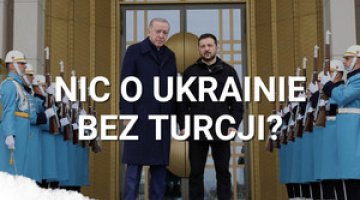Turkey's economy: a story of success with an uncertain future
In the decade since the Justice and Development Party (AKP) came to power, Turkey’s economy has become synonymous with success and well-implemented reforms. Economic development has been the basis of both socio-political stability inside the country and of an ambitious foreign policy agenda pursued by the AKP. However, the risks associated with a series of unresolved issues are becoming increasingly apparent. These include the country’s current account deficit, its over-reliance on short-term external financing, and unfinished reforms, for example of the education sector.
This leaves Turkey exposed to over-dependence on investors, especially from the West. Consequently, Ankara has become a hostage of its own image as an economically successful state with a stable socio-political system. Any changes to this image would cause capital flight, as exemplified by the outflow of portfolio investment[1] and an increase in the cost of external debt[2] that followed the nationwide protests over the proposed closure of Gezi Park last summer. In addition, Turkey remains vulnerable to potential changes in investor sentiment towards emerging markets.
Turkey’s economic success and its roots
The past decade has been a time of economic boom for Turkey. Between 2002 and 2007, the country's economy grew at an annual rate of 7.2%. Turkey also performed relatively well throughout the global financial crisis: after a slowdown in GDP growth to just 0.6% in 2008 and a subsequent recession (which saw a 4.6% contraction in GDP), the economy strongly rebounded, producing 8.8% growth in 2010 and 9.2% in 2011. The economic success was partly the result of a series of reforms initiated by Economy Minister Kemal Derviş in the aftermath the 1999-2001 economic crisis, and partly thanks to the 2000-2001 IMF stabilisation programmes. These reforms were continued by the AKP after the party secured a parliamentary majority in the 2002 elections, which stabilised the country’s political scene and created the right conditions for implementing reforms. The AKP government began the privatisation of loss-making state-owned enterprises, which resulted in an unprecedented inflow of foreign direct investment[3]. It also carried out a successful reform of the banking system, which protected it against the fallout from the global financial crisis. In addition, Turkey adopted a floating exchange rate system, lifted restrictions on foreign capital inflows, tightened fiscal discipline, increased the independence of the Central Bank, and stabilised inflation.
The Turkish economy also benefited from objective conditions: its geographical location, namely, its proximity to EU markets, as well as from a growing population, whose economic potential has not yet been fully exploited (between 2001 and 2012, Turkey’s population increased by 10 million people, reaching 75 million). Turkey has also capitalised on the upward economic trend in other parts of the world and on the launch of accession talks with the EU, which have been a catalyst for further reforms and have had a positive influence on the perception of the country among foreign investors.
One effect of the reforms has been the emergence of a new class of entrepreneurs in central Anatolia, creating an alternative to the industrial class traditionally based in and around Istanbul. The owners of small and medium-sized companies in Central Turkey (Ankara, Kayseri, Gaziantep), who support the AKP, have become the main engine of Turkey's export expansion into the Middle East and North Africa. Over time, the so-called Anatolian tigers amassed sufficient capital to begin competing with Istanbul-based holdings[4] and created an alternative economic elite in the country.
Turkey’s GDP growth, and perhaps even more importantly, a rise in the purchasing power of the population[5], coupled with the widespread belief among the general public that the country’s economy continues to improve, have all contributed to the AKP’s popularity and have formed the basis of an ambitious foreign policy pursued by Ankara. Turkey’s political and economic model has been well received by both the European Union and by countries across the Middle East, and was to be exploited as a potential export product. Turkey’s economic success has also given rise to Ankara’s ambition to play a leading role in the Middle East and to be perceived as an equal partner by the EU.
The weaknesses of Turkey’s economy
Although at the macroeconomic level, Turkey has successfully carried out a series of effective reforms that have helped stabilise its economic system, the lack of a comprehensive reform of the state has prevented it from joining the ranks of developed countries. Among the failings of the AKP has been the lack of education reform - it was not until 2012 that the period of compulsory school education was extended from 8 to 12 years, but even then no measures were taken to improve the quality of educational provision. At the same time, the government decided to put Islamic education on a par with secular education, which has given rise to allegations of the Islamisation of Turkish society[6]. The failure to reform the education system has also had a negative effect on the qualifications of the country’s workforce. Similarly, the government has also failed to overhaul Turkey’s labour market, which is one of the reasons for its low levels of inclusiveness: in 2011, the labour force participation rate for the population was just 50%, and only 28% for women. Moreover, due to increasing demographic pressures, the rate of job creation is lower than the rate at which new generations of workers enter the labour market. Meanwhile, the minimum wage remains relatively high and has not been adjusted to reflect significant differences in the cost of living between different parts of the country (in July of this year, the minimum wage was set at around €400). The tax system remains inefficient and the added value of exports is still low, although there has been some improvement in the structure of Turkish exports (between 2001-2010, the share of medium-technology products in total exports increased from 25% to 40%; source: TEPAV). In addition, the Turkish economy continues to suffer as a result of the country’s corrupt and politicised judicial system (although reform of this was launched last year) and because of strong links between business and politics.
This means that Turkey’s transformation is still in progress and further reforms are needed to bring about the necessary structural changes in its economy. The outcomes envisaged include: an increase in the quality and volume of Turkish exports, stimulating economic growth through exports rather than through domestic consumption[7], improving the skills of the workforce, raising the number of economically active people as well as increasing the productivity and competitiveness of the Turkish economy[8].
Turkey’s perilous deficit
The biggest risk to the Turkish economy is posed by the growing structural deficit in the country’s current account[9] and by its over-reliance on so-called hot money in financing the economy, which leaves it more vulnerable to how the country is perceived by foreign investors. The state of the economy is also contingent on domestic political stability and on the dynamic of geopolitical events taking place in the region, in particular, the conflict in Syria. There is also the added danger that investors might become reluctant to invest in emerging markets - Washington’s decision to adopt a stricter monetary policy could prompts investors to abandon riskier markets, including Turkey[10].
Turkey’s current account deficit is caused by, among other things, a high level of imports, resulting mainly from the country’s reliance on imported energy carriers (in 2012, the cost of energy imports reached 25% of the total value of imports), as well as by a high proportion of imported intermediates used in the production of Turkish export goods[11] - which means that export growth entails an increase in imports. The deficit is also a consequence of Turkey’s high domestic consumption (growth in industrial production increases imports), which is fuelled by easily available consumer credit. However, due to a low level of deposits, local banks are forced to raise capital abroad.
Cuts in energy prices
The government is aware of these risks. Given that over the next decade Turkey’s energy demand is forecast to double, Ankara has been striving to bring down the cost of future energy imports as well as to develop its domestic energy resources (in 2011, 72% of the energy consumed by Turkey came from abroad). The elements of the government’s energy strategy include: a decision to build two nuclear power plants (the first of them is due to be completed in 2023); liberalisation of the electricity and gas market; development of Turkey’s gas infrastructure in order to enable greater diversification of gas supplies and the establishment of a gas market in the country; prospecting for domestic energy resources (e.g. shale gas deposits); development of power plants fired by locally produced brown coal[12]. The need to provide affordable energy for Turkey, coupled with a broad range of security issues, has been one of the reasons for Ankara’s cooperation with Iraqi Kurdistan. In October of this year, Turkey began the construction of a gas pipeline to Iraq’s Kurdistan Region, in the hope of importing 10 bcm of gas a year, at prices significantly lower than those charged by Turkey’s current main gas suppliers: Russia and Iran. The government’s energy strategy also envisages greater energy efficiency and the modernisation of existing power plants. However, given the long-term nature of these measures, they are unlikely to reduce Turkey’s dependence on foreign capital in the immediate future. This, in turn, means that for the time being Turkey remains exposed to the risks associated with a potential increase in energy prices.
Foreign trade
The growth of Turkish exports and the reduction of the country’s dependence on imported energy sources are the two areas most likely to help cut the current account deficit. However, the high share of imported intermediates in export goods remains a major problem for Turkey. Before the financial crisis, the IMF estimated this share at 70%, and any increases in exports directly correlated with increases in imports (as well as with domestic consumption). In the aftermath of the economic downturn, the correlation became less pronounced due to an increase in the export of low-processed goods (food, building materials) to countries across the Middle East and North Africa.
The AKP government has been actively pursuing the policy of promoting Turkish goods abroad and modernising the export structure by increasing the share of high-technology goods in overall exports. Among the measures taken by Ankara has been the establishment of a network of trade advisors in importing countries (since the AKP came to power, the number of such advisors has nearly tripled to more than 200 people). The government has also been providing support to exporters by producing reports on individual markets, as well as by offering them assistance and funding (of up to $7,500) for business trips to establish new trade links. Every two years, the government draws up a list of the most promising export markets (in 2012, Poland was the only EU country included in the list). As in the case of the energy market, the measures aimed at restructuring and stimulating Turkish exports are of a long-term nature and are integrally linked to deep economic reforms. This means that they are unlikely to have a significant effect on Turkey’s current account deficit in the immediate future.
Hot money
An immediate threat to the Turkish economy is posed by the inflow of speculative capital and the risks associated with the banking sector, namely, the low level of savings in local banks (i.e. a high loans to deposits ratio) as well as the heavy reliance of Turkish banks on foreign financing. Turkey’s short-term debt accounts for about a third of its total debt and is generated mainly by banks, which are responsible for about 68% of this debt (June 2013). Meanwhile, the share of short-term liabilities in the total debt of the banking sector is 62% (June 2013). Such a large share of current liabilities in the total debt of the banking sector has raised concerns about the banks’ ability to raise enough capital to pay off their debt[13]. The situation is further aggravated by the persistently high consumer lending figures, which increased by 29% y/y in August (Turkey’s Central Bank intends to curb growth in costumer credit to just 15% in 2013).
Turkey is also exposed to the risks associated with the potential flight of so-called hot money. In 2012, the inflow of portfolio investment into Turkey doubled compared to 2011 and reached $38 billion. However in summer 2013, Turkey experienced an outflow of capital - in June and July the outflow of portfolio investment was estimated at over $4 billion. This was linked to both the protests staged to protect Gezi Park and to the changing attitude among investors towards emerging markets.
In view of the continuing risk of capital flight, it is crucial for Turkey to maintain a positive image among foreign investors. Currently, two of the three largest credit rating agencies (Moody's and Fitch) have put Turkey at investment grade; however, S&P and IHS continue to offer a more cautious assessment of the Turkish economy due to the risks associated with the outflow of capital and with Turkey’s domestic situation.
A race against time
The reforms implemented by the AKP government have focused on the creation of efficient institutions responsible for the regulation of the economy, but have failed to build a competitive and productive economic system, as evidenced by, among other things, the continued dependence of Turkish exports on imported intermediate goods and the structural deficit in the country’s current account balance. To resolve these problems, Ankara needs to carry out further reforms (already included in the government’s development plan for 2014-2018)[14]. Their implementation, however, is contingent on maintaining the current trend in economic development and on ensuring a positive image of Turkey among foreign investors. This task may prove difficult because of the challenges the AKP is facing domestically[15]: an uncertain future for the peace talks with the Kurds, social tensions exposed during the Gezi Park protests, and the upcoming local and presidential elections. In addition, Turkey’s geopolitical position remains precarious due to the ongoing conflict in Syria, the resultant influx of Syrian refugees into the country, the occasional cross-border shelling, and the suggestions that Turkey might become involved in the Syrian conflict. This is coupled with growing instability across the Middle East and the continuing crisis in the eurozone. Finally, Turkey also remains vulnerable to external factors that may inhibit the inflow of foreign capital, such as a potential change in investor sentiment towards emerging markets.
[1] According to Central Bank figures, in June (during the protests) the outflow of portfolio investments reached $3.2 billion. In August, the investments began to return (showing an increase of $1.8 billion) but at a slower rate than in the same month a year earlier (when portfolio investments increased by $2.2 billion).
[2] The average interest rate on Turkish bonds rose from a record low of 5.15% in May to 6.98% in June and peaked at 9.3% in August. In September, the interest rate dropped to 8.8% (Source: CEIC).
[3] Between 2002 and 2012, the cumulative inflow of FDI to Turkey reached $123.8 billion. This compared favourably to 1991-2001 when Turkey attracted just $11.3 billion in FDI (source: Central Bank of Turkey).
[4] Between 1997-2007, the number of companies from Konya, Kayseri and Ankara listed among the country’s 500 largest enterprises by the Istanbul Chamber of Industry increased by 40. Meanwhile, the number of Istanbul-based companies on the list dropped by 108.
[5] GDP per capita at purchasing power parity increased from Intl $8,800 in 2002 to Intl $14,000 in 2007 and reached more than Intl $18,000 in 2012.
[7] In 2012, final consumption expenditure accounted for 84.4% of Turkey’s GDP; exports of goods and services - 26.4%; gross capital formation - 20.28% (source: World Bank). By comparison, in 2001 these figures stood at 80.8%, 27% and 15%, respectively. This suggests that over the past decade the structure of the Turkish economy has not changed considerably.
[8] In the 2013-2014 Global Competitiveness Index report Turkey ranked 44th (down by one place compared to 2012-2013). The factors adversely affecting the competitiveness of the Turkish economy identified in the report are: high taxes, inadequately skilled workforce, red tape and bureaucracy, as well as regulations on foreign currency exchange and tax regulations.
[9] In 2012, Turkey was able to cut its current account deficit from $77.2 billion to $48.9 billion. This was the result of its economic cooling policies (GDP grew by just 2.2% in 2012), which reduced lending and thus also domestic consumption. The reduction of the deficit was also aided by an unprecedented increase in exports to Iran. Ankara posted as ‘exports’ the gold it sent to Iran in payment for Iranian gas (in 2012, the value of Turkish exports to Iran reached $9.9 billion, compared to $3.6 billion in 2011).
[11] According to IMF studies, the share of imported intermediates in export products reached 70% before the 2008-2009 economic crisis. In 2012, the share of imported intermediates was estimated at 48% and the share of capital goods at 14%. The decrease was a result of a higher proportion of low-processed goods (food, construction materials) in exports. Cf. http://www.imf.org/external/pubs/ft/scr/2012/cr12339.pdf
[12] An ambitious plan to construct several coal-fired power plants collapsed after TAQA (UAE) announced that it was suspending the implementation of the project worth $12 billion. http://uk.reuters.com/article/2013/08/26/taqa-turkey-idUKL6N0GR0WN20130826
[13] At the end of June this year, Turkey’s foreign debt stood at $367 billion, of which short-term debt was $125 billion (35%); figures published by the Central Bank of Turkey.




